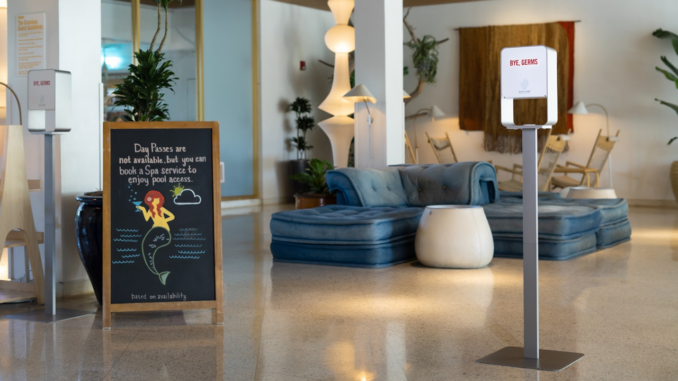
By Ed Krafcik, Head of Business Development & Partnerships at Touchland - 11.13.2020
Prior to the pandemic, it would have been rare to consider hand sanitizer as a critical element in enhancing guest experience. Today, hand sanitizer is the norm and in many cases it is the first thing a guest will see and engage with when they walk into a lobby, and continue to experience throughout their stay. It’s clear the demand and a guest’s expectation for hand sanitizer will be here for the long term and the need for hospitality leaders to reconsider what hand sanitizer means for guest experience, operational budgets, and interior design strategy and aesthetic is paramount as more and more hand sanitizer solutions, products, and brands enter the market.
Hand sanitizer is the latest architectural element in an elevated guest experience
In nearly every public indoor environment you enter today, you’ll see and use hand sanitizer. Like never before, hand sanitizer and PPE-related items (i.e. plexiglass walls, free masks, detailed public health signage, and socially distanced wayfinding elements) are the first touchpoints brands have with their customers.
As interior design teams and brand, marketing, and operations leaders think about this new guest experience, it is clear that the conversation for hand sanitizer is rapidly evolving from an immediate need in response to the pandemic to a long term, permanent and intentional design element – hand sanitizer will soon be a symbol of what a brand stands for and how it is perceived by guests and customers in the same way that bathroom fixtures, appliances, and furniture are. Ultimately, hand sanitizer is rapidly shifting from a basic commodity to an architectural furnishing, and brand, design, and operations teams need to be prepared to act fast and remain informed as they plan long term investment strategies into this new product category.
Do your due diligence and critically analyze your prospective hand sanitizer partner’s supply chain
With the increased number of hand sanitizing brands entering the market, it is extremely important to ask the right questions to ensure the quality of the product you are purchasing and to have confidence that it will be available for years to come. For example, some questions to consider asking your prospective partner include:
- How long have they been in business and how have they handled a sell out of products in the past? (i.e. do they have a process for taking pre orders or assembling waitlists in the case that demand spikes again and they sell out?)
- Are the hand sanitizing products registered with the FDA and are they produced in an FDA-compliant facility? What lab testing has been done to date?
- Where are the products manufactured and are there any potential issues that could prohibit the manufacturer from having refill supplies when you need them?
- Are there any restrictions for how much product you can order at one time? And what is the shelf life?
Lastly, if you are purchasing hand sanitizer through a distributor, are you confident that the sanitizer dispenser refills will be available when you need them? What type of relationship does the distributor have with the manufacturer? Are they importing or is the manufacturer US based? Does the distributor have an exclusive agreement with a single brand or multiple brands? Getting answers to these questions early on can inform your long term strategy for procurement and a sustainable supply of product in increasingly challenging times.
Plan your operational budget on a cost per dose basis and think long term 12-24 months
Given the current usage rates of hand sanitizer in public places and the projected usage rates for years to come, it’s important to evaluate your cost over the long term. Upfront cost is understandably an important consideration, but modeling 12-24+ month proformas to better understand what to expect in terms of the cost of refills is crucial. This modeling will help you compare apples to apples when reviewing products and solutions from multiple hand sanitizer brands.
While many hand sanitizer brands will use gel or foam sanitizing solutions, Touchland designed a liquid based sanitizing formula that is not only known for its hydrating properties, but is also nearly twice as cost efficient as a gel or foam solution. This efficiency is measured in terms of doses per refill cartridge (a liquid based formula like Touchland includes up to 2,000 doses of sanitizer per 1-liter refill cartridge, whereas gel or foam formulas typically averages between 1,000 – 1,300 doses for the same volume). So if you simply evaluate the cost of a refill by volume and not by the total number of doses, you may find yourself underestimating your total cost over a period of time even if the upfront cost is lower.
Measure your success
An investment into hand sanitizer that elevates your brand and guest experience will undoubtedly be scrutinized, especially as revenues are impacted by the pandemic. In addition to pro forma modeling and evaluating total spend over time with permanent sanitizing solutions, if you are piloting different sanitizing dispenser options, important guest experience-centric metrics like change in NPS score or CSAT score are also valuable to implement as soon as possible to determine the immediate impact of brand-aligned hand sanitizer.
 Ed Krafcik is the Head of Business Development & Partnerships at Touchland. Touchland was founded in 2017 with the vision to reinvent hand sanitizer by blending beauty, skincare, and hygiene. Touchland is the first hand sanitizer brand to be awarded Allure’s Best of Beauty Award and was recently nominated as a finalist for Fast Company’s Innovation by Design Award for the Power Mist and Kub. Their hospitality partners today include Virgin Hotels, 1 Hotels, Standard Hotels, Four Seasons, Sofitel, Solage, and many more.
Ed Krafcik is the Head of Business Development & Partnerships at Touchland. Touchland was founded in 2017 with the vision to reinvent hand sanitizer by blending beauty, skincare, and hygiene. Touchland is the first hand sanitizer brand to be awarded Allure’s Best of Beauty Award and was recently nominated as a finalist for Fast Company’s Innovation by Design Award for the Power Mist and Kub. Their hospitality partners today include Virgin Hotels, 1 Hotels, Standard Hotels, Four Seasons, Sofitel, Solage, and many more.
Are you an industry thought leader with a point of view on hotel technology that you would like to share with our readers? If so, we invite you to review our editorial guidelines and submit your article for publishing consideration.
